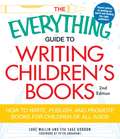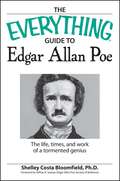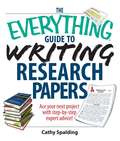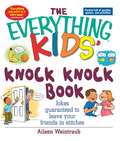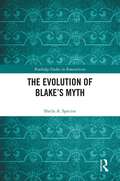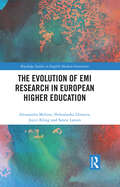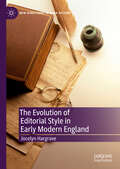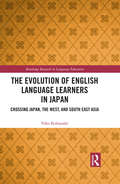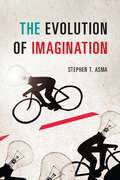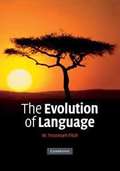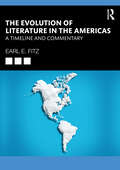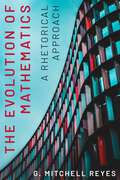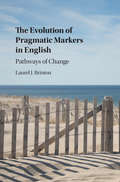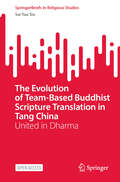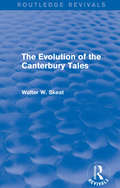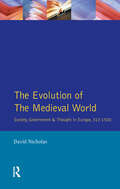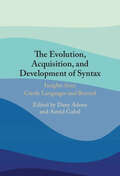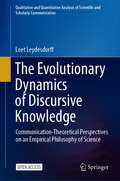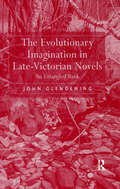- Table View
- List View
The Everything® Guide To Writing Children's Books (2nd Edition)
by Luke Wallin Eva Sage GordonWriting for kids is fun and rewarding--if you can break into the competitive world of children's book publishing. With The Everything Guide to Writing Children's Books, 2nd Edition, you'll learn how to write and promote a children's book that will impress any publisher. Seasoned children's book author Luke Wallin and Eva Sage Gordon will help you build a successful career as a children's book author whether you have only a basic idea or a manuscript ready to go. This clear and concise guide helps you: Formulate an original idea, create an outline, and write the book Learn the basics of children's story-telling, from point of view to story pacing Find helpful writing workshops and conferences Design a winning book proposal, get an agent, and negotiate a contract Create a marketing and publicity plan Use professional and social networking sites to promote your book Full of eye-opening insider information and invaluable writing advice, this is the perfect book for every aspiring children's book author!
The Everything® Guide to Edgar Allan Poe
by Shelley Costa BloomfieldThe genius and orphan son of itinerant actors, Poe led a tragic life and suffered greatly—as much at his own hands as those of Fate. Yet tragedy never stopped him from writing: poems, short stories, literary journalism, and even creating a new genre, the detective story—a contribution so great that the most prestigious writing award for crime fiction, given annually by the Mystery Writers of America, bears his name. The Everything Guide to Edgar Allan Poe is a fascinating guide to the tormented genius, with critical insight into: His difficult childhood His 13-year-old bride The truth about his drug use The enduring mystery of his death Poe led a life as epic as one of his poems. In The Everything Guide to Edgar Allan Poe, you’ll learn all the deepest secrets that haunted this tortured writer, influenced his writing, and ultimately drove him to an early death.
The Everything® Guide to Writing Graphic Novels: From Superheroes to Manga-All You Need to Create and Sell Your Graphic Works
by Mark Ellis Melissa Martin EllisYou've read them, you've loved them, and now you want to write and illustrate them. The Everything Guide to Writing Graphic Novels is your shot at the big time.
The Everything® Guide to Writing Research Papers
by Cathy SpaldingThat important paper is due soon and you don't know where to start. You're out of ideas and out of time. Don't panic-- writing great research papers is not as daunting a task as you think. It's just a process'and withThe Everything Guide to Writing Research Papers, you can master that process in no time. Professional educator and writer Cathy Spalding guides you step ?by-step through the writing process'from brainstorming ideas to polishing your final work. With dozens of timesaving tips on organization, research, and revision, you'll find the actual writing easier than ever before. This easy-to-follow handbook answers all of your questions: What are the different types of research papers'and which should you write? How can you focus your research efforts, saving time and aggravation? Yikes! You're three pages short ? now what? What can you do to protect yourself from plagiarism? How do you find and cite all of your sources? Perfect for high school and college students juggling multiple assignments,The Everything Guide to Writing Research Papersshows you how to take control of your assignments ? before they take control of you!
The Everything® Kids' Knock Knock Book
by Aileen WeintraubThe Everything Kids' Knock Knock Book is full of hilarious sections such as: - Once Upon a Knock Knock- When Fun Comes a Knockin'- Tied Up in Knocks Knocks- Knock Knock Your Socks Off- Who's That Knockin'?
The Evolution of Blake’s Myth (Routledge Studies in Romanticism)
by Sheila SpectorInterpreting Blake has always proved challenging. Hermeneutics, as the on-going negotiation between the horizon of expectations and a given text, hinges on the preconceptions that structure thought. The structure, in turn, is derived from myth, a cultural narrative predicated on a particular set of foundational principles, and organized in terms of the resulting symbolic form. The primary impediment to interpreting Blake has been the failure to recognize that he and much of his audience have thought in terms of two radically different myths. In The Evolution of Blake’s Myth, Sheila A. Spector establishes the dimensions of the myth that structures Blake’s thought. In the first of three parts, she uses Jerusalem, Blake’s most complete book, as the basis for extrapolating the components of the consolidated myth. She then traces the chronological development of the myth from its origin in the late 1780s through its crystallization in Milton. Finally, she demonstrates how Blake used the myth hermeneutically, as the horizon of expectations for interpreting not only his own work, but the Bible and the visionary texts of others, as well.
The Evolution of EMI Research in European Higher Education (Routledge Studies in English-Medium Instruction)
by Joyce Kling Slobodanka Dimova Alessandra Molino Sanne LarsenThis book presents a state-of-the-art of EMI research in European higher education over the last twenty years, offering a comprehensive comparative analysis toward identifying gaps in our understanding of relevant theories, research, and practice. Molino, Dimova, Kling, and Larsen argue for the need to take stock of the progression of EMI research in European HE in order to consolidate scholarship and better inform EMI implementation in new contexts. Each chapter focuses on a different aspect of EMI implementation, including policies, attitudes, language use, assessment, training, learning outcomes, identity, and intercultural communication across five different countries: Denmark, Croatia, Italy, the Netherlands, and Spain. The book brings together the authors' collective work on an annotated database of over 200 resources, featuring a range of publications of varying format, type, and language, as well as information on relevant research questions, methodologies, and findings. This detailed approach allows in-depth discussions on the most widely researched areas in EMI as well as those under-explored toward outlining a way forward for future research in both the European higher education context and on a global scale. This book will be key reading for scholars working in English-medium instruction, World Englishes, English as an international language, English as a lingua franca, and applied linguistics.
The Evolution of Editorial Style in Early Modern England (New Directions in Book History)
by Jocelyn HargraveThis book provides a historical study on the evolution of editorial style and its progress towards standardisation through an examination of early modern English style guides. The text considers the variety of ways authors, editors and printers directly implemented or uniquely interpreted and adapted the guidelines of these style guides as part of their inherently human editorial practice. Offering a critical mapping of early modern style guides, Jocelyn Hargrave explores when and how style guides originated, how they contributed to the evolution of editorial practice and how they impacted the overall publishing of content.
The Evolution of English Language Learners in Japan: Crossing Japan, the West, and South East Asia (Routledge Research in Language Education)
by Yoko KobayashiThis book seeks a better understanding of the sociocultural and ideological factors that influence English study in Japan and study-abroad contexts such as university-bound high schools, female-dominant English classes at college, ESL schools in Canada, and private or university-affiliated ESL programs in Singapore and Malaysia. The discussion is based not only on data garnered from Japanese EFL learners and Japanese/overseas educators but also on official English language policies and commercial magazine discourses about English study for Japanese people. The book addresses seemingly incompatible themes that are either entrenched in or beyond Japan’s EFL context such as: Japan’s decades-long poorly-performing English education vs. its equally long-lived status as an economic power; Japanese English learners’ preference for native English speakers/norms in at-home Japanese EFL contexts vs. their friendship with other Asian students in western study-abroad contexts; Japanese female students’ dream of using English to further their careers vs. Japanese working women’s English study for self-enrichment; Japanese society’s obsession with globalization through English study vs. the Japanese economy sustained by monolingual Japanese businessmen; Japanese business magazines’ frequent cover issues on global business English study vs. Japanese working women’s magazines’ less frequent and markedly feminized discourses about English study.
The Evolution of Imagination
by Stephen T. AsmaConsider Miles Davis, horn held high, sculpting a powerful musical statement full of tonal patterns, inside jokes, and thrilling climactic phrases—all on the fly. Or think of a comedy troupe riffing on a couple of cues from the audience until the whole room is erupting with laughter. Or maybe it’s a team of software engineers brainstorming their way to the next Google, or the Einsteins of the world code-cracking the mysteries of nature. Maybe it’s simply a child playing with her toys. What do all of these activities share? With wisdom, humor, and joy, philosopher Stephen T. Asma answers that question in this book: imagination. And from there he takes us on an extraordinary tour of the human creative spirit. Guided by neuroscience, animal behavior, evolution, philosophy, and psychology, Asma burrows deep into the human psyche to look right at the enigmatic but powerful engine that is our improvisational creativity—the source, he argues, of our remarkable imaginational capacity. How is it, he asks, that a story can evoke a whole world inside of us? How are we able to rehearse a skill, a speech, or even an entire scenario simply by thinking about it? How does creativity go beyond experience and help us make something completely new? And how does our moral imagination help us sculpt a better society? As he shows, we live in a world that is only partly happening in reality. Huge swaths of our cognitive experiences are made up by “what-ifs,” “almosts,” and “maybes,” an imagined terrain that churns out one of the most overlooked but necessary resources for our flourishing: possibilities. Considering everything from how imagination works in our physical bodies to the ways we make images, from the mechanics of language and our ability to tell stories to the creative composition of self-consciousness, Asma expands our personal and day-to-day forms of imagination into a grand scale: as one of the decisive evolutionary forces that has guided human development from the Paleolithic era to today. The result is an inspiring look at the rich relationships among improvisation, imagination, and culture, and a privileged glimpse into the unique nature of our evolved minds.
The Evolution of Language
by W. Tecumseh FitchLanguage, more than anything else, is what makes us human. It appears that no communication system of equivalent power exists elsewhere in the animal kingdom. Any normal human child will learn a language based on rather sparse data in the surrounding world, while even the brightest chimpanzee, exposed to the same environment, will not. Why not? How, and why, did language evolve in our species and not in others? Since Darwin's theory of evolution, questions about the origin of language have generated a rapidly-growing scientific literature, stretched across a number of disciplines, much of it directed at specialist audiences. The diversity of perspectives - from linguistics, anthropology, speech science, genetics, neuroscience and evolutionary biology - can be bewildering. Tecumseh Fitch cuts through this vast literature, bringing together its most important insights to explore one of the biggest unsolved puzzles of human history.
The Evolution of Literature in the Americas: A Timeline and Commentary (Routledge Research in American Literature and Culture)
by Earl E. FitzThis book offers a systematic and comparative history of the evolution of literature in the Americas, from the beginning to the present day. It begins with an introduction that assesses the development of the field and then proceeds to a chapter on the literature of Pre-Columbian and indigenous America. It then moves forward chronologically, from the arrival of the Europeans (beginning in 1492) to the year 2026. Including indigenous literature, the other American literatures represented in the book are those of Canada (both Francophone and Anglophone), the United States, the Caribbean (Francophone and Anglophone), Spanish America, and Brazil. Not every book ever written in the Americas is included, of course; only those that, in the author’s estimation, offer some valid point of comparison with other American literary cultures. These points of comparison include issues of theme, genre, literary periods, literature and other disciplines, such as history, art, music, or politics, cases of influence and reception, and translation. The book’s emphasis is on viewing American literature from a hemispheric and comparative lens.
The Evolution of Mathematics: A Rhetorical Approach (RSA Series in Transdisciplinary Rhetoric)
by G. Mitchell ReyesThere is a growing awareness among researchers in the humanities and social sciences of the rhetorical force of mathematical discourse—whether in regard to gerrymandering, facial recognition technologies, or racial biases in algorithmic automation. This book proposes a novel way to engage with and understand mathematics via a theoretical framework that highlights how math transforms the social-material world.In this study, G. Mitchell Reyes applies contemporary rhetorical analysis to mathematical discourse, calling into question the commonly held view that math equals truth. Examining mathematics in historical context, Reyes traces its development from Plato’s teaching about abstract numbers to Euclidian geometry and the emergence of calculus and infinitesimals, imaginary numbers, and algorithms. This history reveals that mathematical innovation has always relied on rhetorical practices of making meaning, such as analogy, metaphor, and invention. Far from expressing truth hidden deep in reality, mathematics is dynamic and evolving, shaping reality and our experience of it.By bringing mathematics back down to the material-social world, Reyes makes it possible for scholars of the rhetoric and sociology of science, technology, and math to collaborate with mathematicians themselves in order to better understand our material world and public culture.
The Evolution of Modern Fantasy
by Jamie WilliamsonIn this comprehensive study, James Williamson traces the literary history of the fantasy genre from the eighteenth century to its coalescence following the success of Tolkien's work in the 1960s. While some studies have engaged with related material, there has been no extended study specifically exploring the roots of this now beloved genre. Using the Ballantine Adult Fantasy Series (1969-74) as the touchpoint in identifying what Williamson terms the pre-genre fantasy canon, The Evolution of Modern Fantasy contends that what became termed fantasy after the Tolkien boom had its beginnings in a creative literary response to eighteenth century antiquarianism.
The Evolution of Pragmatic Markers in English: Pathways of Change
by Brinton Laurel J.Based on a rich set of historical data, this book traces the development of pragmatic markers in English, from hw't in Old English and whilom in Middle English to whatever and I'm just saying in present-day English. Laurel J. Brinton carefully maps the syntactic origins and development of these forms, and critically examines postulated unilineal pathways, such as from adverb to conjunction to discourse marker, or from main clause to parenthetical. The book sets case studies within a larger examination of the development of pragmatic markers as instances of grammaticalization or pragmaticalization. The characteristics of pragmatic markers - as primarily oral, syntactically optional, sentence-external, grammatically indeterminate elements - are revised in the context of scholarship on pragmatic markers over the last thirty or more years.
The Evolution of Spanish Past Forms (Routledge Studies in Hispanic and Lusophone Linguistics)
by Gibran Delgado-DíazThe Evolution of Spanish Past Forms examines how Spanish past forms have changed diachronically. With examples from Medieval Spanish, Golden Age Spanish, and Modern Spanish literary works, this book demonstrates how language is dynamic and susceptible to change. The past forms considered here include the preterit, the imperfect, the imperfect progressive with estar (temporal to be), the present perfect, the imperfect progressive with other auxiliary verbs, the preterit progressive with estar, and the preterit progressive with other auxiliary verbs. This book will be of interest to scholars and graduate students investigating tense and aspect phenomena in Spanish and other languages, grammaticalization processes, and language variation and change.
The Evolution of Team-Based Buddhist Scripture Translation in Tang China: United in Dharma (SpringerBriefs in Religious Studies)
by Sai Yau SiuOpen Access This open-access book provides a concise analysis of the apex of team-based translation of Buddhist scriptures during the Tang Dynasty, initiated by the notable gathering of translation experts led by Prabhākaramitra. Showcasing the diverse and innovative strategies of translators who joined forces to surmount barriers, this work highlights how their collaborative translation efforts facilitated the spread of Buddhist teachings throughout China. This book brings to light the often overlooked yet crucial roles of these translation teams and examines their organizational structures, translation processes, and the distinct roles of individual members, offering critical insights into the cultural and religious fabric of the period. By enhancing our understanding of the complex dynamics within these institutions, this work also addresses a significant gap in the historical study of sūtra translation in medieval China. It is an essential resource for scholars, students, and enthusiasts of Buddhism, translation studies, and Chinese history.
The Evolution of the Canterbury Tales (Routledge Revivals)
by Walter W. SkeatThe Canterbury Tales by Geoffrey Chaucer, published in 1475, is quite possibly the most famous text written in Middle English and has been studied and analysed countless times over the several hundred years that have passed since original publication. Skeat’s essay, originally published in 1907, aims to explore the organisation of the tales within the whole manuscript. This title will be of interest to students of English Literature
The Evolution of the French Courtesan Novel
by Courtney Sullivan'Sullivan's outstanding book is the first to show how French courtesans were fully-fledged masters of the pen as well as proverbial ladies of the night. We learn how their rewriting of classics such as The Lady of the Camellias and their response to a male "backlash" inspire Colette in previously unseen ways. ' -- Nicholas White, University of Cambridge, UK This book is about the autobiographical fictions of nineteenth-century French courtesans. In response to damaging representations of their kind in Zola and Alexandre Dumas' novels, Céleste de Chabrillan, Valtesse de la Bigne, and Liane de Pougy crafted fictions recounting their triumphs as celebrities of the demi-monde and their outcries against the social injustices that pushed them into prostitution. Although their works enjoyed huge success in the second half of the nineteenth century, male writers penned faux-memoirs mocking courtesan novels, and successfully sowed doubt about their authorship in a backlash against the profitable notoriety the novels earned these courtesans. Colette, who did not write from personal experience but rather out of sympathy for the courtesans with whom she socialized, innovated the genre when she wrote three novels exploring the demi-mondaine's life beyond prostitution and youth.
The Evolution of the Medieval World: Society, Government & Thought in Europe 312-1500
by David M NicholasThis ambitious and wide-ranging study of the European Middle Ages respects the complexity and richness of its subject; always accessible, it is never merely superficial or over-simplistic. Stressing the long-term factors of continuity, evolution and change throughout, David Nicholas discusses the social and economic aspects of medieval civilization, and examines their links with political, institutional and cultural development. Designed for students and non-specialists, his book triumphantly meets the need for a comprehensive survey of the medieval world within the covers of a single authoritative volume.
The Evolution, Acquisition and Development of Syntax: Insights from Creole Languages and Beyond
by Dany Adone Astrid GabelBringing together an interdisciplinary team of scholars, this book explores three interconnected aspects of syntax - its origins and evolution, its acquisition by children, and its role in languages' ongoing development and change. These three distinct areas were linked through Bickerton's most provocative work 'Language Bioprogram Hypothesis' (LBH). This book highlights the discussions on syntax that have emerged over the years as a result of the LBH model. Each chapter include a discussion of Bickerton's work, and a special focus is placed on Creole languages, which provide unique case studies for the study of the evolution, acquisition and development of languages. The book also discusses the relevance of LBH for other natural languages, including sign languages. Shedding light on the relevance of syntax in language, it is essential reading for researchers and students in a wide range of linguistic disciplines.
The Evolutionary Dynamics of Discursive Knowledge: Communication-Theoretical Perspectives on an Empirical Philosophy of Science (Qualitative and Quantitative Analysis of Scientific and Scholarly Communication)
by Loet LeydesdorffThis open access book addresses three themes which have been central to Leydesdorff's research: (1) the dynamics of science, technology, and innovation; (2) the scientometric operationalization of these concept; and (3) the elaboration in terms of a Triple Helix of university-industry-government relations. In this study, I discuss the relations among these themes. Using Luhmann's social-systems theory for modelling meaning processing and Shannon's theory for information processing, I show that synergy can add new options to an innovation system as redundancy. The capacity to develop new options is more important for innovation than past performance. Entertaining a model of possible future states makes a knowledge-based system increasingly anticipatory. The trade-off between the incursion of future states on the historical developments can be measured using the Triple-Helix synergy indicator. This is shown, for example, for the Italian national and regional systems of innovation.
The Evolutionary Imagination in Late-Victorian Novels: An Entangled Bank
by John GlendeningDominated by Darwinism and the numerous guises it assumed, evolutionary theory was a source of opportunities and difficulties for late Victorian novelists. Texts produced by Wells, Hardy, Stoker, and Conrad are exemplary in reflecting and participating in these challenges. Not only do they contend with evolutionary complications, John Glendening argues, but the complexities and entanglements of evolutionary theory, interacting with multiple cultural influences, thoroughly permeate the narrative, descriptive, and thematic fabric of each. All the books Glendening examines, from The Island of Doctor Moreau and Dracula to Heart of Darkness, address the interrelationship between order and chaos revealed and promoted by evolutionary thinking of the period. Glendening's particular focus is on how Darwinism informs novels in relation to a late Victorian culture that encouraged authors to stress, not objective truths illuminated by Darwinism, but rather the contingencies, uncertainties, and confusions generated by it and other forms of evolutionary theory.
The Evolving Citizen: American Youth and the Changing Norms of Democratic Engagement (Rhetoric and Democratic Deliberation #4)
by Jay P. ChildersIt has become a common complaint among academics and community leaders that citizens today are not what they used to be. Nowhere is this decline seen to be more troubling than when the focus is on young Americans. Compared to the youth of past generations, today’s young adults, so the story goes, spend too much time watching television, playing video games, and surfing the Internet. As a result, American democracy is in trouble.The Evolving Citizen challenges this decline thesis and argues instead that democratic engagement has not gotten worse—it has simply changed. Through an analysis of seven high school newspapers from 1965 to 2010, this book shows that young people today, according to what they have to say for themselves, are just as enmeshed in civic and political life as the adolescents who came before them. American youth remain good citizens concerned about their communities and hopeful that they can help make a difference. But as The Evolving Citizen demonstrates, today’s youth understand and perform their roles as citizens differently because the world they live in has changed remarkably over the last half century.
The Evolving Citizen: American Youth and the Changing Norms of Democratic Engagement (Rhetoric and Democratic Deliberation)
by Jay P. ChildersIt has become a common complaint among academics and community leaders that citizens today are not what they used to be. Nowhere is this decline seen to be more troubling than when the focus is on young Americans. Compared to the youth of past generations, today’s young adults, so the story goes, spend too much time watching television, playing video games, and surfing the Internet. As a result, American democracy is in trouble.The Evolving Citizen challenges this decline thesis and argues instead that democratic engagement has not gotten worse—it has simply changed. Through an analysis of seven high school newspapers from 1965 to 2010, this book shows that young people today, according to what they have to say for themselves, are just as enmeshed in civic and political life as the adolescents who came before them. American youth remain good citizens concerned about their communities and hopeful that they can help make a difference. But as The Evolving Citizen demonstrates, today’s youth understand and perform their roles as citizens differently because the world they live in has changed remarkably over the last half century.
